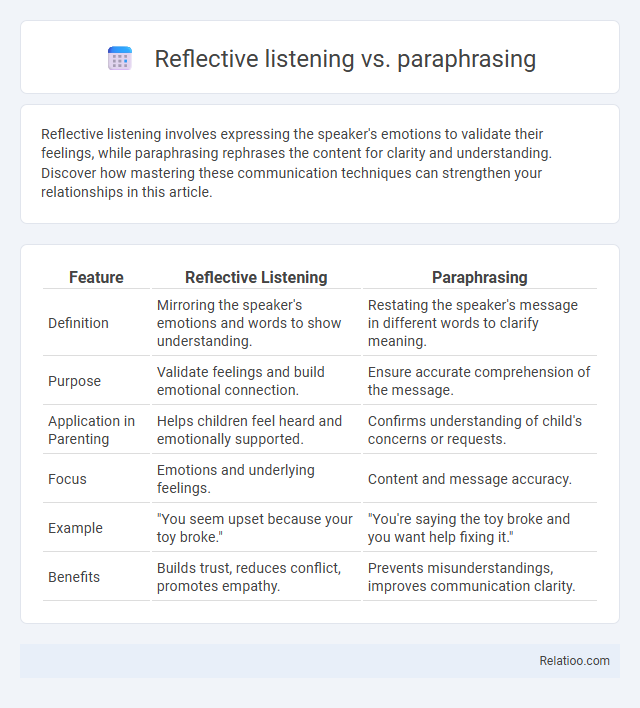Reflective listening involves expressing the speaker's emotions to validate their feelings, while paraphrasing rephrases the content for clarity and understanding. Discover how mastering these communication techniques can strengthen your relationships in this article.
Table of Comparison
| Feature | Reflective Listening | Paraphrasing |
|---|---|---|
| Definition | Mirroring the speaker's emotions and words to show understanding. | Restating the speaker's message in different words to clarify meaning. |
| Purpose | Validate feelings and build emotional connection. | Ensure accurate comprehension of the message. |
| Application in Parenting | Helps children feel heard and emotionally supported. | Confirms understanding of child's concerns or requests. |
| Focus | Emotions and underlying feelings. | Content and message accuracy. |
| Example | "You seem upset because your toy broke." | "You're saying the toy broke and you want help fixing it." |
| Benefits | Builds trust, reduces conflict, promotes empathy. | Prevents misunderstandings, improves communication clarity. |
Understanding Reflective Listening
Reflective listening is a communication technique focused on fully understanding and accurately echoing the speaker's emotions and intentions, which sets it apart from paraphrasing that primarily restates content in different words without delving into feelings. Effective reflective listening involves not only restating your speaker's message but also capturing and validating their emotional experience, fostering deeper connection and empathy. Mastering reflective listening can significantly enhance your ability to engage in meaningful conversations and improve interpersonal relationships.
Defining Paraphrasing
Paraphrasing involves restating Your conversation partner's message in Your own words to confirm understanding and demonstrate active engagement. Reflective listening expands on this by also acknowledging emotions and underlying meanings beyond the words, fostering deeper empathy. Unlike simple paraphrasing, reflective listening combines restating content with mirroring feelings to enhance communication clarity and connection.
Core Differences Between Reflective Listening and Paraphrasing
Reflective listening emphasizes understanding and validating the speaker's emotions by mirroring their feelings and content, while paraphrasing focuses on restating the speaker's message in different words to clarify meaning. Reflective listening captures both the emotional undertone and content, enhancing empathy, whereas paraphrasing primarily targets accuracy and comprehension of the factual information. The core difference lies in reflective listening's intent to connect emotionally, contrasted with paraphrasing's goal of verifying understanding.
The Purpose of Reflective Listening
Reflective listening aims to enhance understanding and build rapport by mirroring the speaker's emotions and content, fostering empathy and trust. Paraphrasing involves restating the speaker's message in different words to clarify meaning without necessarily conveying emotional depth. The primary purpose of reflective listening is to validate the speaker's feelings and encourage deeper communication, making it a crucial skill in counseling, conflict resolution, and active listening scenarios.
The Role of Paraphrasing in Communication
Paraphrasing plays a crucial role in communication by allowing the listener to restate the speaker's message in their own words, ensuring accurate understanding and validation of the original intent. Unlike reflective listening, which emphasizes mirroring the speaker's emotions and underlying feelings, paraphrasing focuses on clarifying content and eliminating misunderstandings. This technique enhances active engagement, fosters empathy, and facilitates more effective dialogue by confirming that the message is correctly received.
Benefits of Reflective Listening
Reflective listening enhances communication by fostering empathy and understanding, allowing speakers to feel heard and validated, which strengthens interpersonal trust and rapport. Unlike paraphrasing, which restates content, reflective listening captures the speaker's emotions and intentions, promoting deeper connection and emotional clarity. This approach effectively reduces misunderstandings and encourages open dialogue, making it a critical skill in counseling, conflict resolution, and leadership contexts.
Advantages of Paraphrasing
Paraphrasing enhances communication by clarifying the speaker's message, reducing misunderstandings, and demonstrating active engagement through restating ideas in the listener's own words. It helps confirm comprehension, encourages further elaboration, and builds trust by showing empathy and validation. Compared to reflective listening, paraphrasing provides a more concise summary that reinforces the speaker's intent without extensive interpretation or emotional reflection.
Common Misconceptions
Reflective listening is often confused with paraphrasing, but reflective listening emphasizes acknowledging emotions and underlying meanings, whereas paraphrasing focuses on restating content in different words. A common misconception is that reflective listening merely repeats information, while it actually validates feelings and encourages deeper communication. Misunderstanding the unique purpose of each technique can hinder effective interpersonal communication and conflict resolution.
When to Use Reflective Listening vs Paraphrasing
Reflective listening is most effective when aiming to validate the speaker's emotions and encourage deeper emotional expression, especially in therapeutic or conflict resolution settings. Paraphrasing suits situations where you need to clarify understanding by restating the speaker's content in your own words, often used in problem-solving or informational exchanges. Choose reflective listening to build empathy and trust, whereas paraphrasing is ideal for confirming accuracy and ensuring mutual understanding.
Enhancing Communication Through Both Skills
Reflective listening and paraphrasing both significantly enhance communication by ensuring clear understanding and validation of the speaker's message. Reflective listening involves mirroring the speaker's emotions and content, fostering empathy and trust, while paraphrasing restates the information in new words to confirm accuracy. Combining these skills reduces misunderstandings and promotes deeper connection, making conversations more effective and meaningful.

Infographic: Reflective listening vs Paraphrasing
 relatioo.com
relatioo.com